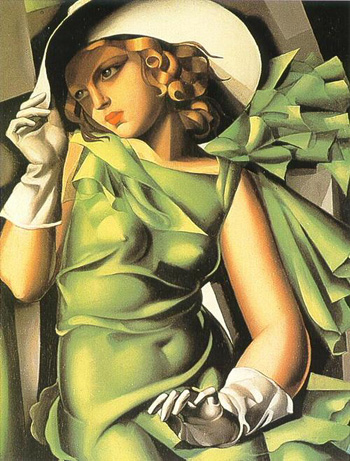
Portrait of a Young Girl in a Green Dressalso known as Jeune fille en vert, Young Girl With Gloves, or Girl in Green with Gloves

|
Perhaps Tamara De Lempicka’s most famous painting, ‘Girl in Green with Gloves’, has been an icon to her artistic style and work throughout her career. Painted in 1929, the ‘Girl in Green with Gloves’ displays a beautiful young woman wearing a flimsy green dress, white gloves, and a large, white hat. The sharp-edged form combined with the bold use of color render the whole strongly dimensional and modern. It appears that the sleek feminine figure with curvaceous lines is holding on to her hat in order to avoid losing it in the breeze, De Lempicka undoubtedly masters the effect of a wind blowing through the painting. A slight sense of eroticism is established by having the dress cling to her body, revealing her breasts and navel through the fabric.
Art Deco in the 30’s
Art Deco followed the more expensive Art Nouveau, but with greater sophistication. Its smooth straight lines held a confidence that the art nouveau era generally lacked, and was far more accessible for mass production.
The Artist
One of the most dominant figures of the art deco years, which peaked from 1925 to 1935, was Tamara De Lempicka. Her detailed portraits of many famous and successful celebrities brought her much fame and fortune before she left Paris and traveled to Hollywood, California. This move furthered her acclaim by making her the popular portrait artist of the stars. She also lived in New York and Houston before settling permanently in Mexico, where she died in 1980.
Analysis and Review
“It can be argued that the Art Deco spirit expressed itself more naturally through portraiture than through any other kind of painting. The quintessential Art Deco portraitist is undoubtedly Tamara de Lempicka. Fashionable society of the 1920s and 30s is now perceived very largely through her eyes” -- Edward Lucie-Smith (Art Critic and Historian)
‘Girl in Green with Gloves’ is currently located at the Musée National d'Art Moderne, Centre Pompidou, Paris.












